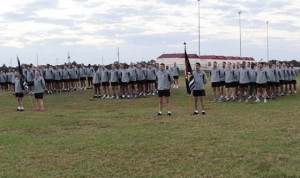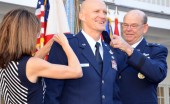Florida Guardsmen join active duty to mark 50th anniversary of Joint Communications Support Element with 50-mile relay run
Written by Contributor // February 7, 2012 // Feature Stories
By Army Master Sgt. Mark Swart
Joint Public Affairs Support Element
MACDILL AIR FORCE BASE, Fla. (Feb. 7, 2012) – Service members from the Joint Communications Support Element (JCSE) – including members of the Florida Air National Guard’s 290th Joint Communications Support Squadron – found themselves in a familiar situation in early December as they relied on teamwork in small groups to accomplish a challenging mission.

After the 50-mile relay, members of the Joint Communications Support Element stand in formation as Col. Stephen Corcoran, JCSE commander, gives a speech on the history of JCSE. The JCSE is the premiere joint communications unit in the Department of Defense and provides communications support on short notice in support of Department of Defense missions around the world. (U.S. Air Force Photo by Airman 1st Class Shandresha Mitchell/ Released)
Running through the night and into the early morning, teams from each JCSE completed a 50-mile relay run the morning of Dec. 9 at the fitness center track on MacDill Air Force Base.
The element, which specializes in sending small teams of communications specialists on short notice to support U.S. forces in contingencies around the world, ran in a mass formation of more than 200 service members back to headquarters where they took time to observe the significance of the day.
Rear Adm. Scott A. Stearney, commander of the Joint Enabling Capabilities Command, the higher headquarters for JCSE, spoke to the unit after the run.
“Because of the many thousands and three generations of service members who have come before you, the next 50 years is just the beginning,” Stearney said. “You all carry a special place in our hearts today.”
He added that leadership, especially from the noncommissioned officers, had been one of the keys to mission success for the element. He said JCSE service members are the “essence of what a joint warrior is today. You have the ability to quickly set up command and control wherever and whenever needed.”
Col. Stephen Corcoran, commander of JCSE, noted that even on special occasions such as this, the mission never stops.
“Nearly one third of JCSE is deployed or in motion right now. Today we stop to reflect on the past 50 years and to think about the future,” he said.
JCSE was originally formed as the Communications Support Element in 1961 with 415 Air Force and Army members; in 1972 the Navy and Marines joined the element and it was renamed JCSE.
Some of the first missions for JCSE included deployment to the Belgian Congo in 1964 in support of Joint Task Force Leo and support during disaster relief after the Brownsville, Texas, floods in 1968.
Today JCSE has the capability for mobile, initial-entry, or early-entry communications support for up to a 40-person Joint Task Force in permissive and non-permissive environments. It can also support a larger joint task force headquarters and two Joint Special Operations Task Force headquarters with anywhere from 40-1,500 users.
JCSE consists of more than 1,000 service members in both active and reserve component forces — including three active duty squadrons, two Air-National Guard Squadrons, and one Army Reserve squadron.
In the past year JCSE has deployed service members in support of: Operation Tomodachi, Japan; Operation Odyssey Dawn, Stuttgart, Germany; Operation Continuing Promise 2011, Central and South America; Operation New Dawn, Iraq; and Operation Enduring Freedom, Afghanistan. The JCSE is a subordinate unit of the U.S. Transportation Command’s Joint Enabling Capabilities Command, based in Norfolk, Va.
###















